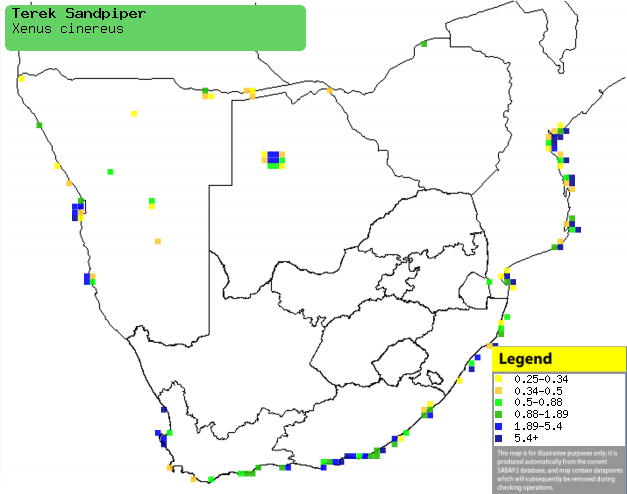|
Xenus cinereus (Terek sandpiper)
Terekruiter [Afrikaans]; Terekruiter [Dutch]; Chevalier
bargette [French]; Terekwasserläufer [German]; Maçarico-sovela [Portuguese]
Life
> Eukaryotes >
Opisthokonta
> Metazoa (animals) >
Bilateria >
Deuterostomia > Chordata >
Craniata > Vertebrata (vertebrates) > Gnathostomata (jawed
vertebrates) > Teleostomi (teleost fish) > Osteichthyes (bony fish) > Class:
Sarcopterygii (lobe-finned
fish) > Stegocephalia (terrestrial
vertebrates) > Tetrapoda
(four-legged vertebrates) > Reptiliomorpha > Amniota >
Reptilia (reptiles) >
Romeriida > Diapsida > Archosauromorpha > Archosauria >
Dinosauria
(dinosaurs) > Saurischia > Theropoda (bipedal predatory dinosaurs) >
Coelurosauria > Maniraptora > Aves
(birds) >
Order: Charadriiformes > Family: Scolopacidae
Distribution and habitat
Mainly breeds in the taiga north of 53° North from southern
Gulf of Finland to eastern Siberia, heading south to the tropical and
subtropical coasts of Australasia, and the eastern coast of Africa, including
southern Africa. Here it is locally common along the coast of Mozambique and
South Africa up to the Western Cape; it is fairly scarce along Namibia's
coastline and has an isolated population in north-central Botswana. It generally
prefers mangroves and mud and sand flats in sheltered bays, estuaries or along
rivers further inland.
|
 |
|
Distribution of Terek sandpiper in southern Africa,
based on statistical smoothing of the records from first SA Bird Atlas
Project (©
Animal Demography unit, University of
Cape Town; smoothing by Birgit Erni and Francesca Little). Colours range
from dark blue (most common) through to yellow (least common).
See here for the latest distribution
from the SABAP2. |
Movements and migrations
Adults mainly leave their breeding grounds in
July, while juveniles follow them in August, eventually arriving in
southern Africa in the period from September-November. Most of them
leave in March and April, rarely April, although juveniles
occasionally don't leave and instead stay for winter.
Food
It mainly eats crabs, crustaceans, insects and fish, doing
most of its foraging solitarily or in loose groups. It is a highly active
forager, plucking prey from the water surface or rapidly moving around with its
bill close to the water so that it can quickly grab invertebrates.
Threats
Not threatened, although habitat degradation, especially of
mangroves, may be causing local population decreases.
References
-
Hockey PAR, Dean WRJ and Ryan PG 2005. Roberts
- Birds of southern Africa, VIIth ed. The Trustees of the John Voelcker
Bird Book Fund, Cape Town.
|
